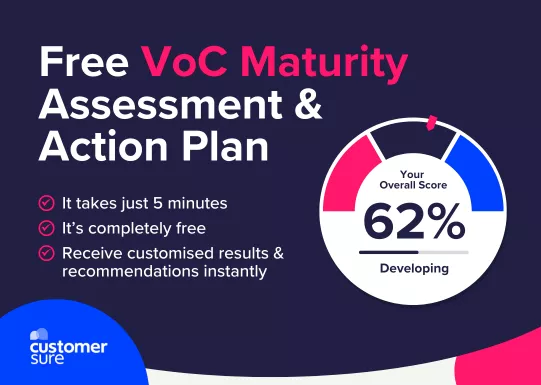

These are the most common pitfalls we’ve witnessed from organisations when they’re evaluating and improving customer experience.
One of the most common mistakes businesses make is disregarding customer feedback.
Some companies fail to actively seek and listen to what their customers have to say, missing out on valuable insights that can inform decision-making. Regularly collecting feedback through surveys, reviews, and social media channels is essential for evaluating and improving customer satisfaction and expectations.
But it doesn’t stop there. Collecting is the first step. There also needs to be a cycle of evaluation internally, proper internal communications to highlight issues and opportunities, and the actual response to the feedback itself. Many businesses underestimate the power of responding to feedback, and it’s something we’ve covered in greater detail in this post.
The Solution? Establish a robust feedback programme, respond promptly to customer feedback, and use the information gathered to make data-driven decisions for enhancing customer experience. (Psst… we can help with that!)
While metrics like Net Promoter Score (NPS) and Customer Satisfaction (CSAT) are valuable indicators, relying solely on quantitative data can be a mistake. Businesses often overlook the qualitative aspects of customer experience. Customer comments paint the picture and show emotions and sentiments, which are equally important in understanding the overall customer journey and what the pain points are.
It’s important to remember that NPS and CSAT, are only proxies for satisfaction. On the positive side, these numbers are useful because they’re a measure of customer sentiment and loyalty and therefore a leading indicator of profitability.
But on the negative side, although they tell you whether there’s a problem and how severe it is, they don’t tell you what it is. To get an improvement in satisfaction scores you need to find, understand and fix the causes of the problems.
Combining quantitative metrics with qualitative insights is vital to gain a clearer picture of customer satisfaction. Many companies are daunted by qualitative feedback and unsure how to analyse it or what to do with it – and we can help with that too.
This is an interesting, much-debated topic that our CEO, Guy Letts, shared his views on with 360 Magazine recently.
An organisation’s customer experience is closely linked to the experience its employees have. Neglecting employee satisfaction and engagement can lead to a lack of enthusiasm and commitment to delivering exceptional customer service. Happy employees are more likely to provide positive customer experiences.
Invest in employee training, foster a positive work environment, and regularly assess employee satisfaction to ensure they are motivated and equipped to deliver excellent customer service. We’ve helped several of our clients collect employee feedback through CustomerSure, enabling them to put as much emphasis on this important area as they do their customers.
Customers expect a seamless experience across various channels, including online platforms, social media, and physical locations. Businesses often make the mistake of offering inconsistent messaging, services, or features across these channels, leading to customer frustration.
It’s crucial to implement an omnichannel strategy that ensures a unified and cohesive experience across all touchpoints. This includes consistent branding, messaging, and user interfaces to create a seamless customer journey. For businesses with multiple sites, like our client Barchester Healthcare, paying attention to the customer experience across the board throughout all sites, is imperative, particularly when considering the line of business and the legislation/potential fallout via the likes of the Care Quality Commission.
The only way of knowing what’s happening for your customers across every touchpoint is to ask them, listen, and act accordingly. You also need to ask for feedback at the times when customers are likely to want to give it – such as after a specific event. Look at your customer journeys and identify the points where it makes sense to ask for feedback.
Customer expectations evolve over time, influenced by technological advancements, industry trends, global events and other businesses. Businesses that fail to adapt and update their customer experience strategies accordingly risk falling behind and losing their competitive edge.
Teams need to be informed about industry trends, monitor customer feedback consistently, and be agile in adjusting strategies to meet changing expectations. Embrace innovation and leverage technology to enhance the overall customer experience.
Our Senior Account Manager, Darren Wake, explains:
“Amazon is a classic example. Their approach to selling and delivering products completely evolved customer expectations as they raised the bar to a whole new level. If businesses are not improving their customer’s satisfaction, they will be going backwards.”
Like most topics, when it comes to Customer Experience, this isn’t an exhaustive list. There’ll no doubt be a swathe of mistakes yet to be made in future as technology and customer needs evolve, but getting the basics right and avoiding these common mistakes is a great place to start.
By prioritsing customer feedback, balancing quantitative and qualitative metrics, investing in employee satisfaction, ensuring consistent customer experiences both online and offline, and adapting to changing expectations, businesses can build a solid foundation for providing exceptional customer experiences. In doing so, they can drive positive change throughout their organisations and not only retain and delight existing customers, but also attract new ones, fostering long-term success and growth.
At CustomerSure, we’re fanatical about helping our customers drive tangible business benefits through their customer feedback process.
Our software is used by customer-centric organisations looking to gain real-time, actionable feedback from their customers, which they use to drive real change and improve performance.
If you want to know why the likes of Philips and Covéa Insurance trust us, why not sign up for a free demo?
We’d love to show you around.

Gain a clear view of how mature your VoC programme is, and receive tailored recommendations to take it to the next level.
Take the assessment »